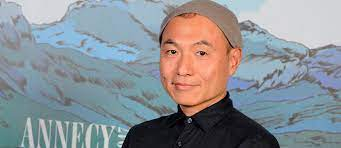Two of his most well-known works are The Tatami Galaxy and The Night is Short, Walk on Girl, which take place in the same modern-day universe. There's no limit tot he time periods that his projects depict, though -- his latest film, which his American theaters last year, is Inu-Oh, which follows the relationship between two entertainers in 14th century Japan and features an electrifying rock soundtrack.
In his interviews on the creation of Inu-Oh, Yuasa often calls back to an imagined connection between himself and the people of the era the movie takes place in, "In my head," he says, "I can hear them saying 'do not underestimate us and sell us short.'" Tomona, one of the main characters, at one point plays the biwa (a traditional Japanese string instrument) behind his head a la Jimi Hendrix.
When asked about the reasoning behind this choice and other "modern" aspects of the movie, Yuasa said "it feels somehow rude, just assuming we can do something but they clearly didn't." This phenomenon he describes is reminiscent of the experiences that Brother Danielson and Elizabeth Gilbert have spoken about. Yuasa's connection is not as intense as Danielson's and Gilbert's, but there is a divinity to it -- maybe not in a religious sense, but certainly in a historic or ancestral one.
The creative concept of combination is prominent in Inu-Oh. The 14th century backdrop of the film combined with the modern rock soundtrack creates a completely unique environment and carves out a distinct identity for the film and its characters.
A common feature of Yuasa's work is the nebulous quality of space and environment. He uses the creative concept of abstraction to enhance his storytelling -- rather than a rigid framework, he considers physical space to be subjective and heavily influenced by the emotions of his characters. In Tatami Galaxy, a dorm room becomes a sprawling maze of itself; in Night is Short a triple decker train accommodates its own banquet hall.
Yuasa also feels strongly about taking breaks from work. The policies of his studio support das off, and the employees don't work long hours overnight, which is a practice adopted by many animation studios. It's possible that this practice contributes to the intricacies of the story and the animation -- taking true time off would prompt implicit cognition.
Unfortunately, Inu-Oh has been said to be Yuasa's farewell to the animation industry, marking his retirement. "I haven't yet reached what I've wanted to achieve," he said in a 2017 interview. If anything else, Inu-Oh is worthy of its title as Yuasa's final project.
Sources:
https://loyolauniversitychicago-my.sharepoint.com/personal/rmorrison_luc_edu/_layouts/15/onedrive.aspx?ga=1&id=%2Fpersonal%2Frmorrison%5Fluc%5Fedu%2FDocuments%2FTeaching%20%2D%20Onedrive%2FHonr%20204d%20Creativity%2FHonr%20204d%20Creativity%20%2D%20SP23%2FClass%20Share%2FReadings%2FWeek%203%20%26%204%20%20%2D%20Processes%2FSmith%26Ward%5FREQUIRED%2Epdf&parent=%2Fpersonal%2Frmorrison%5Fluc%5Fedu%2FDocuments%2FTeaching%20%2D%20Onedrive%2FHonr%20204d%20Creativity%2FHonr%20204d%20Creativity%20%2D%20SP23%2FClass%20Share%2FReadings%2FWeek%203%20%26%204%20%20%2D%20Processes
https://www.awn.com/animationworld/masaaki-yuasa-speaks-many-colors
https://jff.jpf.go.jp/read/interview/masaakiyuasa/
https://www.youtube.com/watch?v=93EMUDqNNow
https://offscreen.com/view/an-interview-with-masaaki-yuasa
https://gamerant.com/inu-oh-masaaki-yuasa-final-film/







I'm not familiar with his work; though I find it interesting that his philosophy promotes breaks, as that is contrary to what I know of Japanese workplace culture and animation workplace culture in general. But it seems to be working well for him, which I suppose says something about the effectiveness of our "grind" culture. I think, for artists, taking breaks can be just as useful to the creative process as working under pressure. Both generate new and different ideas, and I think both are equally valid ways of working.
ReplyDelete